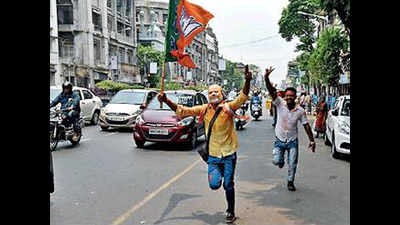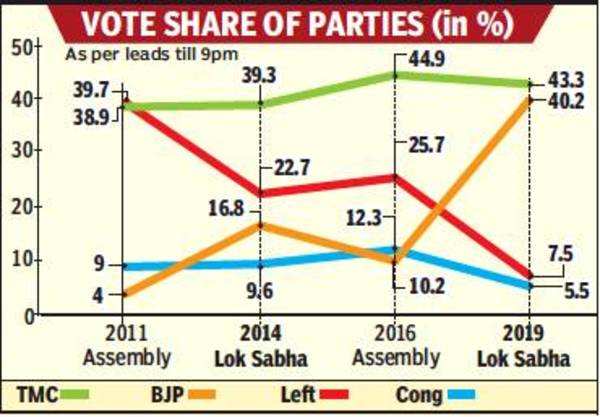- News
- City News
- kolkata News
- West Bengal election results: With 18 seats and 40% vote share, BJP snaps at TMC heels
Trending
This story is from May 24, 2019
West Bengal election results: With 18 seats and 40% vote share, BJP snaps at TMC heels
Bengal’s voters have moved decisively towards a bipolar political configuration, giving the BJP leads in 18 of 42 Lok Sabha seats from the state and, much more importantly, giving the saffron party a clear mandate to take on the Trinamool in the 2021 state elections.

A jubilant BJP supporter sports a Modi mask and runs along Central Avenue in front of the BJP office
KOLKATA: Bengal’s voters have moved decisively towards a bipolar political configuration, giving the BJP leads in 18 of 42 Lok Sabha seats from the state and, much more importantly, giving the saffron party a clear mandate to take on the Trinamool in the 2021 state elections.

The BJP got 40.2% of the votes (counted till 9pm), up from 17% in the 2014 LS polls and only 3.1% less than Trinamool’s 43.3% this time.Interestingly, the Trinamool vote share went up by 3.6% (from its 2014 share of 39.7%) but that gain got swept away by the en-masse consolidation of anti-Trinamool votes in the BJP’s favour.
The CPM-led Left Front bled heavily, seeing its vote share come down to 7.5% (from 29.9% in 2014). The party also faces the ignominy of not having a single representative in the Lok Sabha nearly a century after a Bengali (M N Roy) took the lead in establishing the Communist Party of India (in 1920 in Tashkent).

Leave alone winning a seat, the Left did not manage to come even a close second in any of the constituencies in a state it ruled for 34 years till only eight years ago. And that includes a one-time CPM bastion of Jadavpur, where it had one of its strongest candidates in Bikash Bhattacharya.
The Congress seems poised to hold on to two of its bastions in Bengal — Adhir Chowdhury’s Behrampore and Abu Hasem Khan Chowdhury’s Malda South — despite seeing its vote share go down to 5.5% from 9.6% in 2014.
But it was the CPM’s falling by the wayside that directly helped the BJP as most anti-Trinamool voters moved straight from left to right without spending any time in the centre. The Trinamool, in what is unprecedented in Bengal’s electoral politics, saw its vote share grow but may see its seat share plummet from 34 in 2014 to a possible 22 now (based on leads till 9pm).
More importantly, voters have denied the Trinamool the cushion of too many safe seats. Most of the seats it will manage to retain will come with much-decreased margins (except the core-city constituencies of Kolkata North and South and Jadavpur). From urban constituencies like Howrah to rural constituencies like Arambag, the party has seen its winning margins getting whittled down to uncomfortable levels.
Preliminary assembly segment-wise result data, too, indicated difficult times ahead for Trinamool. An analysis by psephologist Biswanath Chakraborty put the number of assembly segments won by the Trinamool at 158; the BJP, with 128, was breathing down its neck.
Even in Kolkata, where the Trinamool won comfortably, there were a couple of assembly segments (Rashbehari and Chowringhee) that seemed to have gone the BJP’s way, he said.
But kolkata also provided one of the rare silver linings for the Trinamool. It retained Kolkata North, despite a concerted BJP bid, Kolkata South as well as Jadavpur and also managed to increase its margin in all three seats. The Trinamool might sense a winning formula here: appealing to Bengali voters’ pride in their cultural heritage, the card the Trinamool played after the desecration of Vidyasagar’s statue in the wake of an Amit Shah roadshow barely five days before Kolkata went to vote.
But the Trinamool would be feeling hemmed in from all corners. Its Kolkata and South 24 Parganas bastions face a threat from constituencies in North 24 Parganas (Barrackpore and Bongaon). Its hitherto safe seats in urban Howrah now face a threat from Hooghly and its citadel in East Midnapore faces a threat from West Midnapore.
The BJP has breached the agrarian belt of Hooghly and Burdwan, the tribal belt of Purulia-Jhargram as well as middle Bengal (where it has got Bankura and Bishnupur). But the major embarrassment for the Trinamool would be the result from north Bengal, where it has been decimated and where the BJP has won all six seats (Alipurduar, Cooch Behar, Jalpaiguri, Darjeeling, Raiganj and Balurghat); the Trinamool’s first seat — if you come down from the north — would be in the middle-Bengal district of Murshidabad.
The Trinamool’s acute discomfiture is not only geographical; it extends along caste and community lines as well. Going by the seats that it looks set to lose to the BJP — as well as votes in the seats it looks poised to retain — only the minorities seem to have voted overwhelmingly in the Trinamool’s favour (the party seems to be winning an overwhelming majority of seats where Muslims form more than 20% of the electorate). Several caste blocks, like the Scheduled Tribes in western and north Bengal and Scheduled Castes in south Bengal, seem to have favoured the BJP; the Trinamool seems to be winning in only four of the 10 SC-reserved seats and none of the two ST-reserved seats in Bengal.
The road from here to 2021 will be fraught with risks and faultlines, some of which have been exposed by this election and some which may not have surfaced yet. The Trinamool will now have to gear up to face a strong, buoyant number-two party that feels its time has come. Its experiment of propping up the CPM to divide anti-incumbency votes will not work any longer, simply because there are very few CPM votes left in Bengal. It will have to come up with a new formula, besides its development-and-social-welfare programmes, to face a party that will unabashedly use the religion card.
Bengal’s ruling party for eight years will also have to accept the fact that the next two years will be fraught with niggling crises; a strong opposition in the state will now be helped by a strong ruling party at the centre determined to take advantage of every opportunity to undermine the Trinamool government.

The BJP got 40.2% of the votes (counted till 9pm), up from 17% in the 2014 LS polls and only 3.1% less than Trinamool’s 43.3% this time.Interestingly, the Trinamool vote share went up by 3.6% (from its 2014 share of 39.7%) but that gain got swept away by the en-masse consolidation of anti-Trinamool votes in the BJP’s favour.
The CPM-led Left Front bled heavily, seeing its vote share come down to 7.5% (from 29.9% in 2014). The party also faces the ignominy of not having a single representative in the Lok Sabha nearly a century after a Bengali (M N Roy) took the lead in establishing the Communist Party of India (in 1920 in Tashkent).

Leave alone winning a seat, the Left did not manage to come even a close second in any of the constituencies in a state it ruled for 34 years till only eight years ago. And that includes a one-time CPM bastion of Jadavpur, where it had one of its strongest candidates in Bikash Bhattacharya.
The Congress seems poised to hold on to two of its bastions in Bengal — Adhir Chowdhury’s Behrampore and Abu Hasem Khan Chowdhury’s Malda South — despite seeing its vote share go down to 5.5% from 9.6% in 2014.
But it was the CPM’s falling by the wayside that directly helped the BJP as most anti-Trinamool voters moved straight from left to right without spending any time in the centre. The Trinamool, in what is unprecedented in Bengal’s electoral politics, saw its vote share grow but may see its seat share plummet from 34 in 2014 to a possible 22 now (based on leads till 9pm).
More importantly, voters have denied the Trinamool the cushion of too many safe seats. Most of the seats it will manage to retain will come with much-decreased margins (except the core-city constituencies of Kolkata North and South and Jadavpur). From urban constituencies like Howrah to rural constituencies like Arambag, the party has seen its winning margins getting whittled down to uncomfortable levels.
Preliminary assembly segment-wise result data, too, indicated difficult times ahead for Trinamool. An analysis by psephologist Biswanath Chakraborty put the number of assembly segments won by the Trinamool at 158; the BJP, with 128, was breathing down its neck.
Even in Kolkata, where the Trinamool won comfortably, there were a couple of assembly segments (Rashbehari and Chowringhee) that seemed to have gone the BJP’s way, he said.
But kolkata also provided one of the rare silver linings for the Trinamool. It retained Kolkata North, despite a concerted BJP bid, Kolkata South as well as Jadavpur and also managed to increase its margin in all three seats. The Trinamool might sense a winning formula here: appealing to Bengali voters’ pride in their cultural heritage, the card the Trinamool played after the desecration of Vidyasagar’s statue in the wake of an Amit Shah roadshow barely five days before Kolkata went to vote.
But the Trinamool would be feeling hemmed in from all corners. Its Kolkata and South 24 Parganas bastions face a threat from constituencies in North 24 Parganas (Barrackpore and Bongaon). Its hitherto safe seats in urban Howrah now face a threat from Hooghly and its citadel in East Midnapore faces a threat from West Midnapore.
The BJP has breached the agrarian belt of Hooghly and Burdwan, the tribal belt of Purulia-Jhargram as well as middle Bengal (where it has got Bankura and Bishnupur). But the major embarrassment for the Trinamool would be the result from north Bengal, where it has been decimated and where the BJP has won all six seats (Alipurduar, Cooch Behar, Jalpaiguri, Darjeeling, Raiganj and Balurghat); the Trinamool’s first seat — if you come down from the north — would be in the middle-Bengal district of Murshidabad.
The Trinamool’s acute discomfiture is not only geographical; it extends along caste and community lines as well. Going by the seats that it looks set to lose to the BJP — as well as votes in the seats it looks poised to retain — only the minorities seem to have voted overwhelmingly in the Trinamool’s favour (the party seems to be winning an overwhelming majority of seats where Muslims form more than 20% of the electorate). Several caste blocks, like the Scheduled Tribes in western and north Bengal and Scheduled Castes in south Bengal, seem to have favoured the BJP; the Trinamool seems to be winning in only four of the 10 SC-reserved seats and none of the two ST-reserved seats in Bengal.
The road from here to 2021 will be fraught with risks and faultlines, some of which have been exposed by this election and some which may not have surfaced yet. The Trinamool will now have to gear up to face a strong, buoyant number-two party that feels its time has come. Its experiment of propping up the CPM to divide anti-incumbency votes will not work any longer, simply because there are very few CPM votes left in Bengal. It will have to come up with a new formula, besides its development-and-social-welfare programmes, to face a party that will unabashedly use the religion card.
Bengal’s ruling party for eight years will also have to accept the fact that the next two years will be fraught with niggling crises; a strong opposition in the state will now be helped by a strong ruling party at the centre determined to take advantage of every opportunity to undermine the Trinamool government.
End of Article
FOLLOW US ON SOCIAL MEDIA










